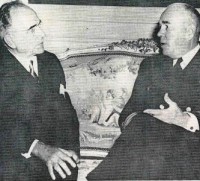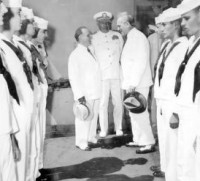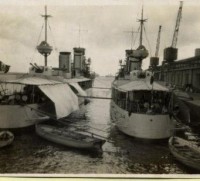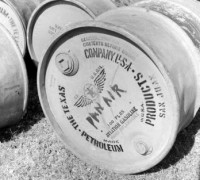- COMMANDER SOUTH ATLANTIC
10)BRAZIL MOVES TOWARD WAR
The Admiral, aboard the Memphis, visited Recife again early in May 1942. He at once had a conference with several Brazilian Generals, including the new Area Commander, General Leitão de Carvalho, who had just succeeded Mascarenhas de Moraes. His real business, however, was with Brigadier Eduardo Gomes, Commander of the Air Zone. The latter was now thoroughly awake to the danger to Brazil by the German subs.
Anxious to do all in his power to cooperate; Gomes offered the services of the Força Aerea Brasileira in the North. He was taken at his word, as the Admiral at once presented him with a combined Force Operation Plan for joint signature. After a momentary hesitation, Gomes signed his name. He was taking unusual initiative here, as ordinarily Brazilian officers were reticent about acting on their own.
The plan provided for dividing all available planes and Tenders into two Task Groups, Laranja (Orange) and Azul (Blue). Group Laranja consisted of U. S. Navy Patrol Planes plus the Tenders assigned to the Task Force Twenty Three. Group Azul included all FAB planes available on Northeast Brazil. Laranja would make semi-weekly patrols of the shipping lane from Belem to Rio, be prepared to scout any assigned area, maintain a reserve striking force, and base Tenders as directed.
Azul would patrol the coasts, navigable rivers, and inlets, from Fortaleza to Maceio, and maintain a reserve striking group. On establishing submarine contact, the two Groups should lend mutual aid in carrying out the primary mission, namely destruction of the enemy, and should maintain air coverage of the danger area until the elimination of the menace.
Where combined action might be required, the senior officer present should be the coordinator. Fuel for the operation of the Task Groups should be furnished by the Recife Naval Observer. Having been successful with Brigadeiro Gomes, Admiral Ingram decided to try his luck with Admiral Dodsworth Martins. Here he encountered a somewhat more timid man.
Dodsworth Martins personally favored the plan proposed to him, which provided for inshore patrol by five Task Groups. Two would consists of Brazilian ships, and one of American ships, with the other two furnished by Groups Laranja and Azul. Yet he would not accept it for operational purposes until he had consulted the Ministerio da Marinha in Rio, a matter which required some time. “Anyhow, I have them on the jump,” wrote the Admiral. “Everything they have will move subject to my recommendations.” By this time the Brazilians had agreed to four very important American requests.
Any air field or seaplane base in their country, with all its utilities, was now available to Task Force Twenty Three. Land based personnel of the Force could have arms at either bases or air fields. Arsenals at Recife and Bahia had been made available for storage of bombs and ammunition. Construction necessary for the housing of U. S. personnel At Natal, Recife, Maceio, and Bahia had been approved.
As lesser concessions, the Brazilians had agreed to the setting up of a Base Hospital at Recife. This was the genesis of the famous Knox Dispensary at Boa Viagem, for which plans were made at once. Brazil, moreover, would accept the introduction of U. S. Army planes, with the proviso that they should operate under Admiral Ingram, the one U.S. Commander in whom the Brazilians felt absolute confidence. American Infantry had been suggested to guard airfields, but this was something the local authorities were not yet ready to allow, although in time they yielded even on this point.
As was previously noted, the Winslow and Jouett made submarine contacts on May 7 and 9 respectively and probably destroyed the German underwater craft. For the rest of May no more decisive contacts occurred. On the 23rd, the ships of Task group Baker attacked a submarine in Lat. 01º 51”S Long. 36º 08”W, with probably negative results. Three days later, the planes of VP-83 attacked a sub, perhaps the same one, a little farther south, but there was no evidence of any damage inflicted.
A good part of the Force’s strength was absent during much of May. The situation in the French West Indies had become temporarily critical. Early in the month, the Admiral had ordered the Cincinnati, Sommers, and Davis to report to the Commander Caribbean Sea Frontier for duty off Martinique in blockading the French in that area. The Memphis, Jouett, and Winslow soon followed, and all these ships were in the Martinique vicinity by the 12th. The Admiral accompanied them as Senior Officer Present took command of the Task Force Twenty Three units, plus the Destroyers Blakely and Biddle.
With these he established a blockade patrol off Fort the France. It did not last long, because on the 13th an ultimatum was issued to Admiral Robert, Commanding the French Naval Forces at Martinique, which provided that he make his ships unfit for war. Yet within the required time he yielded, and the Task Force Twenty Three units were free to go their way.
The Memphis and Winslow left for Miami, the Cincinnati for New York, the Jouett sailed for Recife, and the Davis and Sommers remained temporarily in the West Indies. While the main strength of the force was thus diffused, the report came of fresh German submarine activity in Brazilian waters. The victim this time was Lloyd Brasileiro steamer, Comandante Lyra. This ship was torpedoed near São Roque by a German submarine on the evening Monday May 18, but did not sink.
The report was picked up by the Commander Task Group 23.6, and relayed to the Force. Groups 23.2 and 23.3, consisting of the Milwaukee and Moffet and Omaha and McDougal, respectively, at once turned toward the position of the Brazilian SOS to hunt and destroy the sub. Thogh both Groups were returning from extended patrol and were low in fuel, they proceeded at high speed.
The situation was at first complicated by a dispatch from Captain of the Port at Recife, giving an erroneous position for the Lyra, but the American ships resolutely proceeded toward the first location given. Late on Tuesday forenoon, the Milwaukee and Moffet, which had originally been 60 miles nearer the scene, arrived and found the Lyra burning so badly that boarding seemed impracticable. They set out in search of survivors and of the submarine which had made the attack.
The Lyra had four boats, one of which was not used. One of the others could not be found by the searching vessels, but managed to reach the coast with nine survivors. Task Force 23.2, meanwhile, picked up the other two boats, containing the Captain and 41 men. Planes had patrolled the area overhead constantly since the torpedoing; hence the boat parties had known they were sure to be rescued.
The Omaha and McDougal had reached the scene early in the afternoon, just as several explosions occurred on board of the Lyra. Despite the danger, a salvage party from the Omaha boarded the Brazilian ship, looked her over, and considered her salvable. However, she would have to be towed, and it would not do to immobilize a Cruiser for such an operation.
Hurried calls for help went to Recife and Natal, and assistance was requested from the Brazilian Navy, via Naval Operations and the Local Naval Observers. On Wednesday afternoon the Thrush arrived from Natal and took the Comandante Lyra in tow, bound for Fortaleza.
The American ships of the Task Group 23.3 remained in the vicinity, to allow the Milwaukee and Moffet time to proceed to Recife for fuel. The plan was for these to return later and take over the escort, thus giving the Omaha and McDougal an opportunity to replenish their own supplies. Meanwhile the survivors from the Comandante Lyra were being questioned.
Several of the believed that the Spanish steamer Monte Gobea, which had passed them shortly before the torpedoing, had sent the submarine a message that revealed their position. The Monte Gobea had meanwhile gone on to Recife, and lay there at anchor when the Omaha arrived, but nothing could be proved.
Friday night, May 22nd, the Brazilian tug Heitor Perdigão joined the Group and the tow and thereafter aided the Thrush. On Sunday, the refueled Milwaukee and Moffet rejoined and took part in the hunt for the submarine, which was known to be still nearby. Planes from VP-83 also entered the sub chase. The enemy craft was contacted several times ant attacked. Probably the attacks were not fatal, but it is believed that the submarine was somewhat damaged.
The fact that no other attacks on shipping in this area took place for some time, may reasonably be attributed to the injury suffered by the sub from the American Air and surface craft. Brazilian gratitude for the prompt American action in saving the Comandante Lyra was spontaneous. Ambassador Caffery received a letter of thanks from the Government. From the Lloyd Brasileiro Company, owners of the ship, came a check for $50,000 as a donation to the Navy Relief Society.
The month of June was a quiet one, being confined mostly to patrol and convoy. Two submarine contacts were made with negative results. On the 24th, a report came in saying that two enemy U-boats had gone aground off the mouth of the Para River. The Admiral ordered the Jouett to look for them, and the Commander VP-83 instituted a day and night search, during which he based one division at Belem. Probably the report was erroneous in the first place, since after two days of combing, not a sign of a submarine could be observed and the hunt was called off.
A few minor changes in the composition of the Force took place in June. The Humboldt, a small auxiliary seaplane tender, arrived during the month and relieved the Greene as tender for the VP-83, which now had two divisions present, both based on Natal. HMS Diomede was released from Task Force 23 for refit in the United Kingdom, but did not leave the area until the following month. July also proved to be a light month for combat activity.
No submarine contact occurred, and the only addition to the Force was the Fuel Oil Barge Aurora, which was purchased from the Brazilians in Rio de Janeiro. The Admiral did not assume jurisdiction over her until early August, when she arrived in Recife and was refitted alongside the Patoka. On August 9, now known as YO 138, she became a part of Task Force Twenty Three.
In July, some significant steps were taken to better the Liaison, both with the British and the Brazilians. Commander J.P.W. Furze, R. N., British Naval Attaché in America, visited Recife on the 11th in company with Mr. P. S. Schor, British Admiralty Assistant. There they conferred with Admiral Ingram, several members of his staff, the British and American Naval Attachés from Rio, the Recife Naval Observer, and Capitão de Corveta Archimedes Botelho Pires de Castro, of the Brazilian Navy.
The subject of discussion was the arrangement of a communications system with the British Intelligence Staff. His Majesty’s Officers at the conclusion, sent a recommendation to their Admiralty, which was accepted. It called attention to the fact that the Commander Task Force Twenty Three needed all information regarding ship movements in his area, as well as Naval Intelligence Reports of an operational nature.
It was therefore recommended that Admiral Ingram receive from the Intelligence Officers in Montevideo, Kingston, Freetown, and Capetown the same information as British warships received. This was an important step in unifying the South Atlantic Campaign.
Though for obvious reasons the matter received no publicity at the time, July was notable in Recife for the passing through of convoy AS4 southward bound. It may be that, when the history of the entire war is written, AS4 will be considered the most important group of freighters conducted from the United States to a foreign port.
In June and July 1942, Rommel had captured Tobruk , swept the British across Egypt, shattering their defenses at Mersah Matruh, and had pressed to El Alamein before being stopped. With a much shorter communication line than that of the English, the German leader seemed to be poising for another and possibly fatal attack.
At this point, in response to pleas from Winston Churchill, Convoy AS4 was prepared in New York. It numbered ten ships, loaded with 500 American made tanks, complete with technical equipment and crews. AS4 left New York on July 13, and when not far out of port lost one ship to a German submarine. The damage was made up immediately by loading another freighter with the same cargo as that lost and sending her to join the convoy.
On July 21, these ships made their first MOMP ( Navy designation of Mid Ocean Meeting Point) where their escort was taken over by ships of Task Force Twenty three. These consisted of the Omaha and Juneau, Cruisers and the Davis and Sommers, Destroyers. The following day the Memphis and the Jouett joined the escort, though they dropped out after a certain danger zone had been passed. The original four ships brought the convoy into Base Fox (Recife) on July 23.
Fuelling was quickly attended to and departure took place within forty hours of arrival. On August 5, the convoy reached its second MOMP, where it was turned over to the British. The rest of the voyage was around of the Cape of Good Hope and up the east coast of Africa to the Red Sea and Egypt. The tanks were unloaded and arrived at the front in time to be in the first Battle of El Alamein, in October, where Rommel attacked and Montgomery threw him back.
A little later, the British took the offensive and their crushing victory paved the way for the liberation of all North Africa. Prime Minister Churchill gave credit to these American tanks for having turned the tide. The fueling facilities at Recife had made possible their arrival on schedule.
At no time, at least until rounding the South African Cape, had these ships been out of danger. German Intelligence was able to follow their progress, step by step. At the time the convoy was in Recife, a German radio broadcast in Portuguese, beamed at Brazil, stated where it was and threatened its destruction, which fortunately was averted. On the way home, having disposed of its valuable cargo, the convoy lost a ship, the Zandaam in the South Atlantic. A raft was picked up containing three survivors who had been afloat for over eighty days, and who were brought into Recife.
HyperWar - Commander South Atlantic Force. U.S. Naval Administration in WW II



